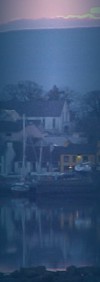


|

Ennistymon
(Inis Diomain - Diaman's river meadow)
A small but colourful market town standing on the banks of the River
Cullenagh. The river makes a very pleasant walk with its famous waterfalls and has excellent fishing.
The town grew around an O'Brien castle, built in 1588, and was the
birthplace of Brian Merriman, the celebrated poet and hedge schoolmaster.
The Catholic parish church desrerves a visit, being built on the
site of St. Mainchin's Church (580) with a later church (1778) in its graveyard.
Carn Connachtach, Ballydeely,(5 km north-northwest) is a striking
bronze age burial mound, 8 m high and about 100 m in diameter.
Frost writing in 189,3 believed the correct name to be Carn Mac
Tail, the burial place of Mac Tail, son of Broc, chieftain of Corcomroe
and inauguration place of the chieftains of Corcomroe.
Folk lore says that the cairn is the burial place of the defeated
Connaught army, (hence the name).
Lahinch
(Leacht Ui Chonchuir - O'Connor's Grave)
Lies on the Alantic coast and is a popular holiday resort, noted
for its 18-hole championship golf course,  fine beach and great surfing. fine beach and great surfing.
There is an Entertainment Centre beside the promenade, which is
open all summer and provides all types of entertainment from bingo to traditional music.
Dough Castle, built by Donnchadh O'Connor in 1422, later the
property of the O'Briens, lies to the north of Lahinch.
Liscannor
(Lios Ceannuir - Ceannur's Fort)
Is a small fishing village on the far side of Liscannor Bay.
The beach to the west of the village is a popular spot.
The ruined castle was originally built in the 12th century by the
O'Connors, later becoming a O'Brien stronghold occupied by Sir
Turlough O'Brien during the threatened invasion at the time of the Spanish Armada (1588).
Kilmacreehy, or St. Macreehy's Church (12th century) was built on
the site of a famous 6th century school founded by St. Macreehy.
The Inventor of the submarine ]ohn P. Holland, was born in Castle
Street, renamed Holland Street in his honour. A headstone, from the
U.S. Navy, commemorating his career can be viewed at the harbour.
Tradition claims that there is a "lost city" and church of Kilstephen
under Liscannor Bay. The key to the church lies buried with the Ossianic
hero, Conan, under his pillar stone on Slieve Callan.
The waters of St. Brigid's Well are believed to have miraculous powers to heal.
Pilgrims travelled from Clare and the Aran Islands for the Lughnasa festivities
on the last Saturday of July and continuing onto 'Garland Sunday' in Lahinch.
The Irish name for 'Garland Sunday' is taken from Crom Dubh, a pre-christian deity.
Cliffs of Moher
(Ailltreacha Mothair)
 These majestic cliffs stand almost 200m above the Altlantic and
stretch 8 km from Hag's Head to a point beyond O'Brien's Tower.They are also
the home of a wide varity of birds.
These majestic cliffs stand almost 200m above the Altlantic and
stretch 8 km from Hag's Head to a point beyond O'Brien's Tower.They are also
the home of a wide varity of birds.
The name comes from a ruined promontory fort, Mothar, which was
replaced by a signal tower during the Napoleonic wars.
There is a Visitor Centre providing tourist facilities, tea room,a
photographic exhibition and a craft shop.
Hag's Head, (perhaps Mal of Malbay,)
is a large rock formation which
resembles a seated woman looking out to sea. The point can only be
reached by foot but affords spectacular panoramic views of cliffs,
sea caves and ocean.
O'Brien's Monument was erected in 1853 by Cornelius O'Brien, M.P. as
an observation point on the highest point of the cliffs.  On a clear
day one can see as far as the Kerry Mountains, the Aran Islands and the Twelve Bens of Connemara.
A stack or rock pillar 70 m high called Breanan Mor is another great
viewing-point.
On a clear
day one can see as far as the Kerry Mountains, the Aran Islands and the Twelve Bens of Connemara.
A stack or rock pillar 70 m high called Breanan Mor is another great
viewing-point.
  
|
|

















|

